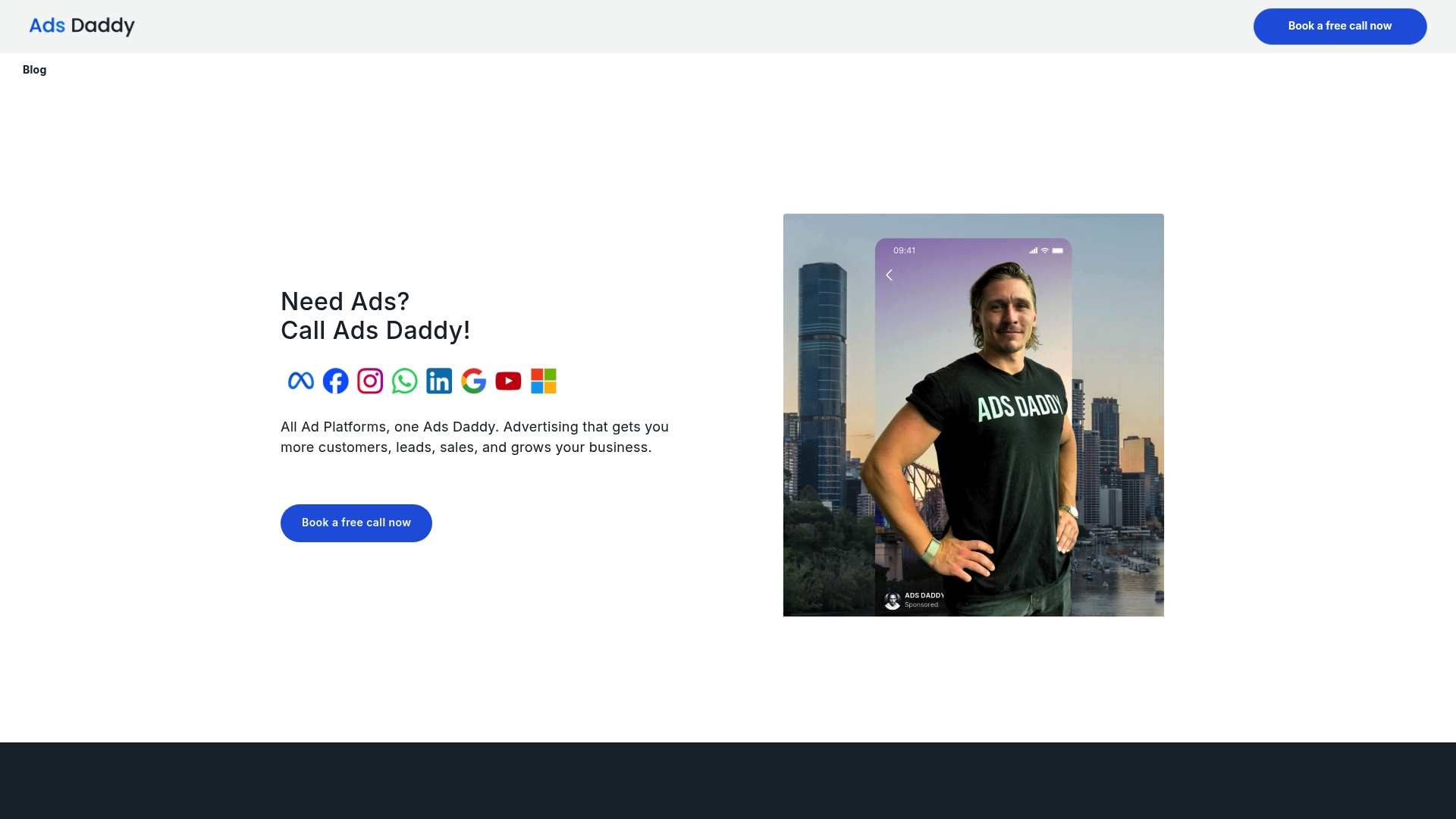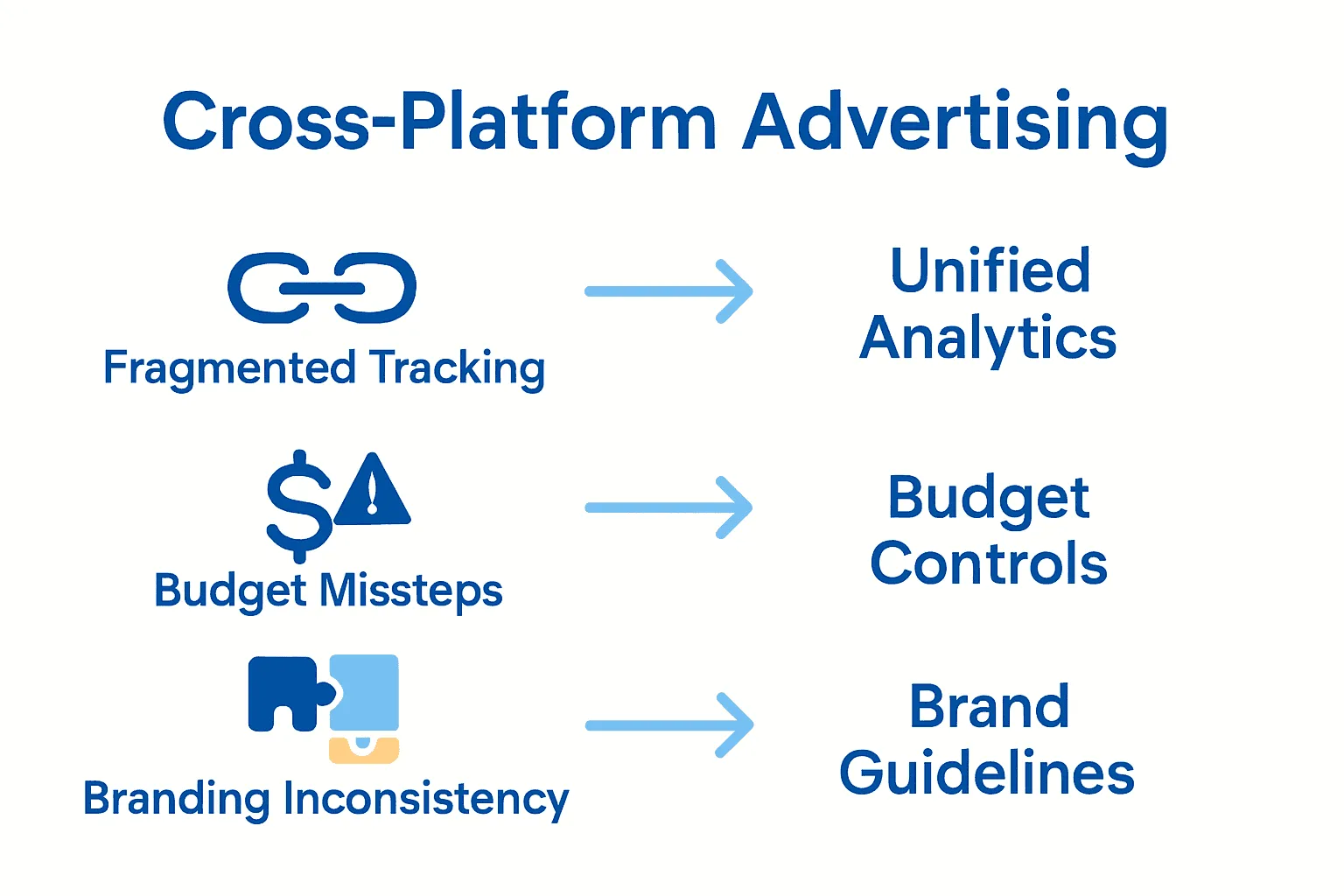Did you know that Australian cross-platform ad campaigns can boost product awareness and purchase intent by up to three times compared to single-channel efforts? Businesses today face customers who bounce between apps, sites, and screens all day long. With attention so divided, understanding how to reach people everywhere they go becomes a business necessity. This guide unwraps the proven strategies and real examples behind effective cross-platform advertising, helping you connect with modern audiences and maximize each marketing dollar.
Table of Contents
- Cross-Platform Advertising Demystified
- Types Of Cross-Platform Ad Campaigns
- How Cross-Platform Advertising Works
- Real-World Applications For Aussie Brands
- Critical Pitfalls And Proven Power Moves
Key Takeaways
| Point | Details |
|---|---|
| Strategic Consistency | Cross-platform advertising requires a unified brand message that adapts to various digital environments to enhance audience engagement. |
| Audience Behavior Mapping | Understanding where and how your audience interacts with digital content is crucial for optimizing ad placements and maximizing impact. |
| Integration Across Channels | Effective campaigns integrate digital and traditional channels to create seamless user journeys and improve brand recall. |
| Avoiding Common Pitfalls | A well-defined strategy, real-time performance monitoring, and adaptive content are key to navigating the complexities of cross-platform advertising successfully. |
Cross-Platform Advertising Demystified
Cross-platform advertising is your digital marketing Swiss Army knife – a strategic approach that transforms scattered ad efforts into a laser-focused audience acquisition machine. According to research from the Native Advertising Institute, this method involves running native ad campaigns across multiple digital environments, strategically positioning your message where your potential customers actually hang out.
At its core, cross-platform advertising means delivering a consistent brand message across websites, mobile apps, social media channels, and digital platforms. Think of it like a coordinated marketing symphony, where every instrument plays the same tune but reaches different ears. As experts at The Media Ant explain, the goal is creating an integrated advertising strategy that speaks directly to your target audience, regardless of which digital space they’re occupying.
Why does this matter for your business? Simple. Modern consumers don’t live on just one platform. They’re scrolling Instagram during breakfast, checking LinkedIn at lunch, and browsing Google in the evening. Fragmented attention requires a fragmented approach. By spreading your advertising across multiple channels, you:
- Increase brand visibility
- Build multiple touchpoints with potential customers
- Maximize your advertising ROI
- Create a more comprehensive customer journey
Smart marketers understand that cross-platform advertising isn’t about being everywhere – it’s about being strategic everywhere. Discover our guide on digital marketing strategies to learn how to execute this approach effectively.
Types Of Cross-Platform Ad Campaigns
Cross-platform ad campaigns aren’t one-size-fits-all. They’re strategic compositions designed to capture audience attention across multiple digital landscapes. According to research from the Native Advertising Institute, these campaigns can take several distinctive forms that maximize brand visibility and engagement.
One powerful approach is the multi-device campaign. This strategy involves creating native ads that seamlessly transition between desktop and mobile platforms. Imagine an ad that looks stunning on a laptop during work hours and then elegantly adapts to a smartphone screen during an evening commute. By ensuring consistent messaging and visual design across devices, brands create a unified experience that feels intentional and professional.
Another sophisticated type is cross-channel content syndication. As experts highlight, this involves distributing native advertising across multiple publishers and content networks. Think of it like planting marketing seeds in different fertile digital soils. Some compelling examples include:
Here’s a comparison of common cross-platform ad campaign types:
| Campaign Type | Description | Key Benefit |
|---|---|---|
| Multi-device Campaign | Native ads adapted for desktop & mobile | Consistent experience across devices |
| Cross-channel Syndication | Content distributed to multiple publishers/networks | Expanded reach & visibility |
| Integrated Digital & TV | Coordinated TV and online promotions | Enhanced awareness & recall |
| Social & Website Integration | Social ads aligned with website content | Higher engagement & conversions |
- TV advertisements complementing digital marketing efforts
- In-store promotions synchronized with online campaigns
- Social media ads integrated with website content
- Content that adapts its format to each platform’s unique style
The magic happens when brands build awareness on one platform while strategically converting audiences on another. Learn more about advanced ad targeting techniques to refine your cross-platform approach and maximize your marketing impact.
How Cross-Platform Advertising Works
Cross-platform advertising isn’t just throwing ads everywhere and hoping something sticks. It’s a sophisticated dance of strategic placement, audience understanding, and consistent messaging. According to Venz Media, the core principle is reaching your audience precisely where they spend their time, regardless of device or platform.
The mechanics are both art and science. Businesses must first map out their audience’s digital journey – understanding which platforms they use, when they use them, and how they interact with content. This means deep diving into customer behavior, tracking device usage patterns, and identifying the digital touchpoints that matter most. By creating a unified brand narrative that smoothly transitions across channels, you transform fragmented interactions into a cohesive marketing experience.
Successful cross-platform advertising requires several critical components:
- Consistent brand messaging across all platforms
- Adaptive content that feels native to each channel
- Strategic tracking of audience interactions
- Seamless user experience from first touchpoint to conversion
- Real-time performance optimization
The goal isn’t just visibility – it’s creating a recognizable brand experience that feels intentional and personalized.
As experts at Fresco Creative emphasize, the magic happens when your messaging remains consistent yet dynamically tailored to each platform’s unique environment. Explore our guide on advanced advertising strategies to master this intricate marketing approach.
Real-World Applications For Aussie Brands
Australian brands aren’t just surviving in the digital ecosystem – they’re absolutely thriving through strategic cross-platform advertising. The local marketing landscape has become a playground for innovative campaigns that seamlessly blend digital and traditional channels, delivering jaw-dropping results that make global markets sit up and take notice.
Take the IAB Australia Cross Platform Case Study on Colgate, which revealed something game-changing: advertising campaigns that combine online, TV, and print can amplify product awareness, purchase intent, and ad memorability by up to three times. This isn’t just theory – it’s proven strategy that local businesses can leverage immediately. Small to medium enterprises can transform their marketing from scattered attempts to precision-guided missiles of brand communication.
Real-world success stories showcase the power of strategic cross-platform approaches:
- Local cafes boosting foot traffic through geo-targeted social media ads
- E-commerce stores connecting Instagram storytelling with targeted Google ads
- Service businesses creating seamless user journeys across multiple digital touchpoints
- Retail brands synchronizing in-store promotions with digital campaign messaging
Moreover, a groundbreaking study by ThinkNewsBrands uncovered that premium news platform advertising across print and digital can generate six times higher brand lift compared to generic internet placements.
Learn from successful brand-building strategies to transform your marketing approach and dominate your industry.
Critical Pitfalls And Proven Power Moves
Cross-platform advertising sounds simple. Throw some ads across different platforms, right? Wrong. According to the Native Advertising Institute, this strategy is a complex minefield filled with potential landmines that can blow up your marketing budget faster than you can say “campaign fail”.
The challenges are real and multifaceted. Data integration becomes a nightmare, tracking gets complicated, and maintaining consistent brand messaging across platforms feels like herding digital cats. Businesses often stumble into common traps like inconsistent branding, platform-specific communication failures, and runaway costs that transform promising campaigns into money-burning disasters.
Here are the critical power moves to dodge those pitfalls:
- Develop a unified strategy before spending a single dollar
- Use cross-platform analytics tools religiously
- Adapt native ads to each platform’s unique user experience
- Create platform-specific content templates
- Monitor performance metrics in real-time
- Be ready to pivot quickly
As experts at Fresco Creative emphasize, the secret sauce is creating a strategy that aligns perfectly with your campaign goals while remaining flexible enough to adapt. The brands that win aren’t those with the biggest budgets – they’re the ones with the smartest, most nimble approach. Discover advanced targeting strategies to transform your cross-platform game from rookie to professional.
Ready to Master Cross-Platform Advertising and Outpace Your Competition?
You have just learned how cross-platform advertising can turn your scattered digital efforts into a powerful, unified brand journey. If you are feeling overwhelmed by fragmented campaigns or struggling to see real ROI across different ad platforms, you are not alone. Many Australian businesses find it tough to stitch together consistent messaging, navigate tricky ad formats, and reach customers wherever they spend time. The article highlighted the pain of disjointed campaigns and the need for a truly strategic, data-driven approach supported by expert tools and campaign management.

Stop letting your competitors capture your audience while you juggle multiple systems and inconsistent results. Trust a team that specialises in high-performance ads for businesses of every size. Visit AdsDaddy.com to see how our experts connect Facebook, Google, Instagram, YouTube, LinkedIn, and more into one seamless campaign. Explore client stories and discover detailed service descriptions and real results. Ready to connect your entire marketing game and boost your visibility fast? Get started now and take your cross-platform advertising to the next level.
Frequently Asked Questions
What is cross-platform advertising?
Cross-platform advertising refers to a strategic approach that delivers consistent brand messaging across multiple digital environments, including websites, mobile apps, and social media channels. It aims to reach potential customers where they spend their time online.
What are the benefits of cross-platform advertising?
The benefits of cross-platform advertising include increased brand visibility, multiple touchpoints with potential customers, maximized advertising ROI, and a more comprehensive customer journey that seamlessly transitions across various channels.
How do you measure the success of cross-platform advertising campaigns?
To measure success, businesses should track key performance metrics such as engagement rates, conversion rates, user interactions across platforms, and overall return on investment (ROI). Utilizing cross-platform analytics tools can help in evaluating performance.
What are some common types of cross-platform ad campaigns?
Common types of cross-platform ad campaigns include multi-device campaigns, cross-channel content syndication, integrated digital and TV promotions, and social media ads aligned with website content. Each type aims to create a cohesive brand experience across various platforms.



